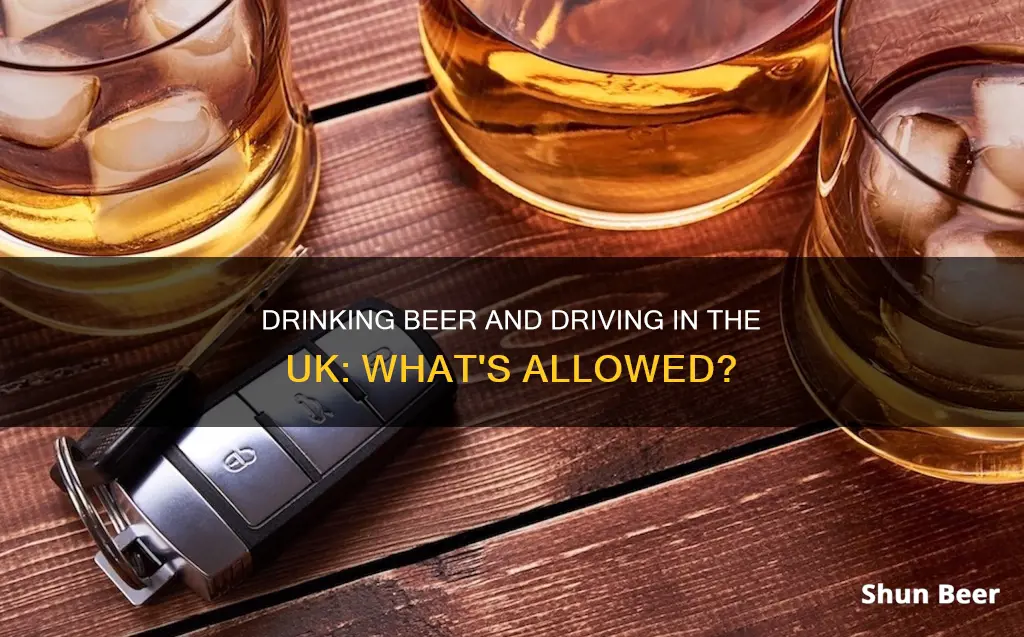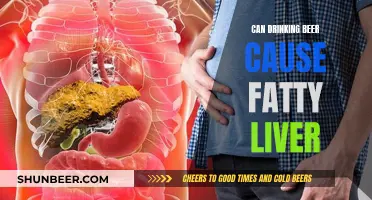
Drinking and driving is a serious offence in the UK, with strict alcohol limits in place for drivers. The limits are based on the amount of alcohol detected in someone's breath, blood or urine, and vary depending on where you are in the UK. In England, Wales and Northern Ireland, the drink-drive alcohol limit for drivers is 80mg of alcohol per 100ml of blood, 107mg of alcohol per 100ml of urine, and 35 micrograms of alcohol per 100ml of breath. In Scotland, the limits are lower, with a maximum blood alcohol level of 50mg per 100ml of blood. But how does this translate to the number of drinks you can have? And is it ever safe to drink and drive?
What You'll Learn

Alcohol affects everyone differently
In the UK, the drink-drive alcohol limit for drivers in England, Wales, and Northern Ireland is 80 mg of alcohol per 100 ml of blood, 107 mg per 100 ml of urine, or 35 micrograms per 100 ml of breath. In Scotland, the limits are lower, with a blood alcohol limit of 50 mg per 100 ml, 67 mg of alcohol per 100 ml of urine, or 22 micrograms per 100 ml of breath. These limits are based on scientific measurements, but it's important to remember that alcohol affects each person uniquely.
While the legal limits provide a guideline, there is no one-size-fits-all approach to alcohol consumption and driving. Some people may feel safe to drive after two pints, while others may be over the limit after just one drink. This variation is due to individual differences in how the body absorbs and processes alcohol. Factors such as sex, weight, what you've eaten, and stress levels can influence how alcohol affects you.
To ensure safety, it's recommended to refrain from drinking if you plan to drive. Alcohol can impair your judgement, slow your reactions, and increase your risk of accidents. Even a single drink can affect your ability to drive, and the more alcohol in your system, the greater the impact. It's best to avoid drinking altogether if you need to get behind the wheel, as there is no guaranteed way to stay under the limit when drinking.
Additionally, it's important to note that alcohol levels in your system can continue to rise for up to three hours after you stop drinking. This means that even if you feel sober, you might still be over the legal limit. To be extra cautious, it's advisable to wait for 12 to 24 hours after drinking before driving, especially if you consumed a significant amount of alcohol.
Beer After a Workout: Good or Bad Idea?
You may want to see also

The legal limit in England, Wales and Northern Ireland
In England, Wales and Northern Ireland, the drink-drive alcohol limit for drivers is:
- 80mg of alcohol per 100ml of blood
- 107mg of alcohol per 100ml of urine
- 35 micrograms of alcohol per 100ml of breath
These are the hard stats, but what this means in real terms can be hard to decipher. So, in general, alcohol limits are broken down into comprehensible bite-size units called… units. One unit of alcohol is measured as 8mg or 10ml of pure alcohol.
Units are a way of determining the amount of alcohol you’re consuming, but these should be taken as a rough guide only. Why? Because there’s no one-size-fits-all when it comes to units, as alcohol affects everyone differently. Your sex, weight, age, diet, and metabolism all play a part in how you process alcohol, as do factors like stress. That’s why some people feel safe to drive after two pints, and others can’t after one.
As a general benchmark, adults process, on average, one unit of alcohol per hour. A single shot of spirits equates to one unit of alcohol. Therefore, you would need to wait at least one hour before driving. However, the alcohol levels in your bloodstream can continue to rise for up to three hours after, depending on the variables above. That’s why it’s challenging to determine your personal drink-driving limit, and why the advice is always: if you plan to drink, don’t drive.
In England, Wales and Northern Ireland, the current driving limit is approximately three units for women and four units for men. A standard 4% lager has 2.3 units, but if you opt for a 5.2% craft beer, you’d be consuming 3 units. A standard glass of wine is 2.3 units, whereas a large glass is 3.3 units.
There is no set time limit that means it’s safe for you to drive after drinking alcohol. Because everyone reacts differently to alcohol, it's difficult to know how long it will be before it leaves your system. The length of time you need to wait until you’re completely sober can depend on the amount and type of alcohol you drank, so your waiting period may be different every time you drink. In general, you can expect a unit of alcohol to take around an hour to be processed by your body, but this isn’t always the case. To be extra safe, it’s best to leave 12 to 24 hours between the time you finish drinking and the time you drive, especially if you drank a lot of alcohol.
Beer and Dexamethasone: Is It Safe?
You may want to see also

The lower limit in Scotland
In the UK, drinking and driving is a definite no-go. Alcohol affects your driving ability in several ways, including impairing your judgement, slowing your reaction time, and making it difficult to focus on driving, among other things. The UK government website estimates that around 280 deaths in 2019 were caused by drivers who were over the drink-driving limit.
The drink-driving limit in Scotland is lower than in the rest of the UK. In Scotland, the drink-drive alcohol limit is:
- 50mg of alcohol per 100ml of blood
- 67mg of alcohol per 100ml of urine
- 22 micrograms of alcohol per 100ml of breath
To put this into context, a standard 4% lager has 2.3 units, and a standard glass of wine (175ml) with 12% ABV would be 2.1 units. However, it's important to remember that these numbers are just estimates, and there are many factors that affect how alcohol is processed by the body. These include weight, age, sex, metabolic rate, diet, and stress levels.
Because of these varying factors, it's challenging to determine your personal drink-driving limit. The general advice is to avoid drinking any alcohol if you plan to drive. If you've been drinking, it's best to wait 12 to 24 hours before getting behind the wheel, especially if you've consumed a significant amount of alcohol.
Beer and Diarrhea: Should You Drink or Ditch?
You may want to see also

How alcohol affects your driving ability
Drinking alcohol can have a significant impact on your driving ability, even if you only consume a small amount. Alcohol is a depressant drug that slows down the central nervous system, including the brain, impairing your ability to drive safely in several ways.
Firstly, alcohol can cause feelings of relaxation and drowsiness, which may lead to falling asleep at the wheel. It also impairs your ability to concentrate, reducing your vigilance and making it difficult to understand what is happening around you. This can result in slower reactions to unexpected events and hazards on the road.
Additionally, alcohol affects your coordination and impairs your vision. It slows down reflexes and decreases your ability to steer, use the pedals appropriately, and maintain your lane position. Your peripheral vision is reduced, making it challenging to see other cars, pedestrians, and obstacles that are not directly in front of you.
Alcohol also impairs judgement and increases risk-taking behaviour. This can lead to overconfidence and failure to obey road rules, further increasing the risk of accidents.
The effects of alcohol on driving ability vary from person to person and depend on factors such as sex, weight, age, diet, metabolism, and stress levels. There is no one-size-fits-all approach to determining how alcohol will affect an individual's driving ability. As such, it is generally recommended that if you plan to drink, you should avoid driving altogether.
Beer and Golo: What You Need to Know
You may want to see also

The consequences of drinking and driving
Drinking and driving is a dangerous combination that can lead to serious, sometimes fatal, consequences. Alcohol impairs judgement, slows reaction time, and makes it difficult to focus, affecting a person's ability to control their vehicle or speed, and reducing their coordination. These effects can lead to accidents, injuries, and even deaths. In the UK, around 280 deaths in 2019 were caused by drunk drivers, and 85,000 drivers are convicted of drunk driving each year.
If you are caught drinking and driving in the UK, you may face strict drink-driving penalties, including a driving ban, an unlimited fine, or even imprisonment. The police may request that you take a breathalyser test, and refusing to comply can lead to arrest. If you fail the test, you will be taken to a police station for further testing, and if you are found to have too much alcohol in your system, you will face charges.
The legal alcohol limit for driving in England, Wales, and Northern Ireland is 80 mg of alcohol per 100 ml of blood, 107 mg of alcohol per 100 ml of urine, or 35 micrograms of alcohol per 100 ml of breath. In Scotland, the limits are lower, at 50 mg of alcohol per 100 ml of blood, 67 mg of alcohol per 100 ml of urine, or 22 micrograms of alcohol per 100 ml of breath. These limits are difficult to translate into a specific number of drinks, as the rate at which alcohol is absorbed and processed depends on various factors such as weight, age, sex, metabolism, stress levels, and whether food has been consumed.
To avoid the risks and legal consequences of drinking and driving, it is best to abstain from alcohol completely if you plan to drive. Alternative transport options, such as public transportation or designated drivers, should be arranged if you intend to consume alcohol. If you have already been drinking and are feeling uncertain about your ability to drive, it is crucial to make alternative arrangements rather than risk getting behind the wheel.
Drinking Beer While Taking Allegra: What You Need to Know
You may want to see also
Frequently asked questions
The UK's official advice is that if you are driving, you should avoid drinking alcohol altogether. Even small amounts of alcohol can affect your ability to drive, and there is no reliable way to drink and stay within the limit. The limit in England, Wales, and Northern Ireland is 80mg of alcohol per 100ml of blood, 107mg of alcohol per 100ml of urine, or 35 micrograms of alcohol per 100ml of breath. In Scotland, the limit is lower: 50mg of alcohol per 100ml of blood, 67mg of alcohol per 100ml of urine, or 22 micrograms of alcohol per 100ml of breath.
There is no set time limit that guarantees it is safe to drive after drinking alcohol. It can be difficult to know how long it will take for the alcohol to leave your system, as this depends on various factors such as your weight, age, sex, metabolism, stress levels, and the type and amount of alcohol consumed. In general, you can expect your body to process one unit of alcohol per hour, but this is not always the case. To be extra safe, it is recommended to leave 12 to 24 hours between drinking and driving.
If you are caught drinking and driving, the police may request that you take a breathalyser test. Refusing to comply can lead to arrest, while failing the test will result in further testing at a police station. If you are found to be over the legal limit, you will face charges, including an unlimited fine or imprisonment, depending on the seriousness of the offence. You could also face a driving ban.







